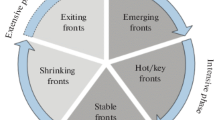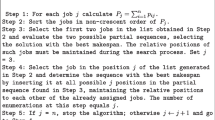Abstract
Measurement of the effectiveness of science policies is analyzed as a multi-level problem. Journal-journal citations are discussed as a potential candidate for a domain beyond the control of policy-makers and authors or research groups and therefore may function as a relatively stable and easily accessible baseline for the ‘calibration’ of outputs and outcomes of science policy. A method is developed, usingSCPsJCRs which is then applied to the two cases of water pollution and humanisation of labor. This method can also be used as a simple indicator for the development of journal-journal citation patterns over time.
Similar content being viewed by others
Notes and references
Sources for such variance have been sought in the social and intellectual organization of the sciences as well as in the organization of the external relations of scientists. An attempt to systematize the former perspective can be found in: R. D. WHITLEY,The Intellectual and Social Organization of the Sciences, Oxford University Press, Oxford, 1984. For the latter perspective, see: K. KNORR-CETINA,The Manufacture of Knowledge. An Essay on the Constructivist and Contextual Nature of Science, Pergamon Press, Oxford/New York, 1981. See for a recent review: H. M. COLLINS, The Sociology of Scientific Knowledge: Studies of Contemporary Science,Annual Review of Sociology, 9 (1983) 265.
“Whatever one's final assessment ofKuhn's view may be, it is clear that his diagnosis succeeds in a way thatMerton's does not, because it embraces the specific activities, theories and concepts of the scientist.” (S. B. BARNES, R. G. A. DOLBY, A deviant viewpoint,Archives Europeennes de Sociologie, 9 (1970) 3.)
This point has been most vigorously made by the representatives of the so-called ‘strong programme’, but is at the background in other sociology of science programmes as well. For ‘the strong programme’ see: D. BLOOR,Knowledge and Social Imagery, Routledge and Kegan Paul, London/Boston, 1976, pp. 1–19.
In 1970 a research programme on science studies was launched at the Starnberg Max-Planck-Institut. The two programmatic articles of the groups were: G. GÖHME, W. v. d. DAELE, W. KROHN, Alternativen in der Wissenschaft,Zeitschrift für Soziologie, 1 (1972) 302; G. BÖHME, W. v. d. DAELE, W. KROHN, Finalisierung der Wissenschaft,Zeitschrift für Soziologie, 2 (1973) 128.
G. BÖHME, W. v. d. DAELE, R. HOHLFELD, W. KROHN, W. SCHÄFER, T. SPENGLER,Die gesellschaftliche Orientierung des wissenschaftlichen Fortschritts, Suhrkamp, Frankfurt/M, 1978.
W. v. d. DAELE, W. KROHN, P. WEINGART, (Hrsg.)Geplante Forschung, Suhrkamp, Frankfurt/M, 1979. See also: W. v. d. DAELE, P. WEINGART, Resistenz und Rezeptivität der Wissenschaft — Zu den Entstehungsbedingungen neuer Disziplinen durch wissenschaftspolitischen Steuerung,Zeitschrift für Soziologie, 4 (1975) 146.
G. KÜPPERS, P. LUNDGREEN, P. WEINGART, Umweltprogramm und Umweltforschung, in:Op. cit., note 6,, pp. 239–286.
Cf. I. SPIEGEL-RÖSING,Wissenschaftsentwicklung und Wissenschaftssteuerung, Athenäum Verlag, Frankfurt a. M., 1973, pp. 106–131.
W. v. d. DAELE, et al.,Mission Orientation in Science, Science Dynamics, Amsterdam, 1982, p. 10.
Op. cit., note 6.
Y. DRORR,Design for Policy Studies, Elsevier, New York/Amsterdam, 1972.
Cf. KNORR-CETINA, 1981.Op. cit., note 1.
See also: K. E. STUDER, D. E. CHUBIN,The Cancer Mission. Social Contexts of Biomedical Research, Sage, Beverly Hills/London, 1980, pp. 269 f.
D. de SOLLA PRICE, Networks of Scientific Papers,Science, 149 (1965) 510.
Other indicators, such as impact and immediacy factors of journals, can easily be computed from these data. See: E. GARFIELD, Citation Analysis as a Tool in Journal Evaluation,Science, 178 (1972) 471.
F. NARIN, M. CARPENTER, N. C. BERLT, Interrelationships of Scientific Journals,Journal of the American Society of Information Science, 23 (1972) 323. See also: M. P. CARPENTER, F. NARIN, Clustering of Scientific Journals,Journal of the American Society of Information Science, 24 (1973) 425.
There is some evidence that particularistic criteria may be influential even at this level, particularly in the social sciences. See also: W. C. YOELS, The Structure of Scientific Fields and the Allocation of Editorships on Scientific Journals: Some Observations on the Politics of Knowledge,The Sociological Quarterly, 15 (1974) 264.
E. GARFIELD, Citation Analysis of Scientific Journals,Citation Indexing, Wiley & Sons, New York, etc., 1979, pp. 148–239.
G. HIRST, Discipline Impact Factors: A Method for determining Core Journal Lists,Journal of the American Society for Information Science, 29 (1978) 171.
F. NARIN et al. 1972 (op. cit., note 16 ). used a two-step model instead of this three-step model.
E. E. ROSKAM, J. C. LINGOES,Nonmetric Multidimensional Scaling GKLR MINISSA-1. Standard Version, June 11, 1974.
Cf. A. J. ASHTON,The use of cluster analysis techniques on biotechnology journal citation data, MSc Thesis, Technology Policy Unit, University of Aston, Birmingham, 1980.
A factor, like a cluster in cluster analysis, has to be labelled with hindsight. A variable's loading on a factor is analogous to the distance of that variable from the centre of a cluster in cluster analysis. (The higher the factor loading, the closer to the centre of the cluster.) Unlike cluster analysis, a journal can appear in more than one factor, and hence participate in more than one subject area. Moreover, with factor analysis we get a measure of the proportion of the common and unique variance of each variable. Cf. E. NADEL, Commitment and Co-Citation: An Indicator of Incommensurability in Patterns of Formal Communication,Social Studies of Science, 13 (1983) 255, notes 22 and 23.
J. CRAMER, R. HAGENDIJK, Aquatic Ecology in the Netherlands: What is being done by whom?Hydrobiological Bulletin, 17 (1) (1983) 77.
Bundesministerium für Forschung und Technologie (Hrsg.),Ein Programm und seine Wirkungen, Analyse von Zielen und Aspekten zur Forschung “Humanisierung des Arbeitslebens” Campus, Frankfurt/New York, 1982.
Op. cit., note 14..
For the political backgrounds of this field, see also: L. LEYDESDORFF, P. v. d. BESSELAAR, Squeezed between Capital and Technology. On the Participation of Labour in the Knowledge Society,Acta Sociologica (forthcoming).
Op. cit., note 7. ; see also: J. CRAMER, W. v. d. DAELE, Is Ecology an ‘Alternative’ Natural Science?,Synthese (forthcoming).
Of course, this is also the case for ‘citation’, which is used here as a measure of the proximity of journals to one another. In citation analysis, for example ‘citations’ can be a measure of indebtedness.
Op. cit., note 14..
Op. cit., note 13..
Author information
Authors and Affiliations
Rights and permissions
About this article
Cite this article
Leydesdorff, L. The development of frames of references. Scientometrics 9, 103–125 (1986). https://doi.org/10.1007/BF02017235
Received:
Issue Date:
DOI: https://doi.org/10.1007/BF02017235




